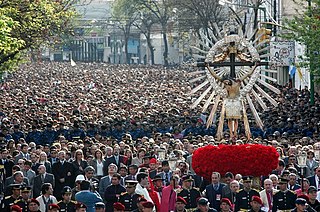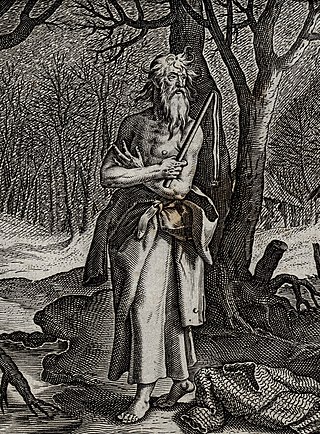
Mortification of the flesh is an act by which an individual or group seeks to mortify or deaden their sinful nature, as a part of the process of sanctification.

Flagellation, flogging or whipping is the act of beating the human body with special implements such as whips, rods, switches, the cat o' nine tails, the sjambok, the knout, etc. Typically, flogging has been imposed on an unwilling subject as a punishment; however, it can also be submitted to willingly and even done by oneself in sadomasochistic or religious contexts.

A scourge is a whip or lash, especially a multi-thong type, used to inflict severe corporal punishment or self-mortification. It is usually made of leather.

Penance is any act or a set of actions done out of repentance for sins committed, as well as an alternate name for the Catholic, Lutheran, Eastern Orthodox, and Oriental Orthodox sacrament of Reconciliation or Confession. It also plays a part in confession among Anglicans and Methodists, in which it is a rite, as well as among other Protestants. The word penance derives from Old French and Latin paenitentia, both of which derive from the same root meaning repentance, the desire to be forgiven. Penance and repentance, similar in their derivation and original sense, have come to symbolize conflicting views of the essence of repentance, arising from the controversy as to the respective merits of "faith" and "good works". Word derivations occur in many languages.

A cilice, also known as a sackcloth, was originally a garment or undergarment made of coarse cloth or animal hair worn close to the skin. It is used by members of various Christian traditions as a self-imposed means of repentance and mortification of the flesh; as an instrument of penance, it is often worn during the Christian penitential season of Lent, especially on Ash Wednesday, Good Friday, and other Fridays of the Lenten season.

In medieval music, the Geisslerlieder, or Flagellant songs, were the songs of the wandering bands of flagellants, who overspread Europe during two periods of mass hysteria: the first during the middle of the 13th century, and the second during the Black Death in 1349. The music was simple, sung in the vernacular, often call-and-response, and closely related to folk song; indeed some of the flagellant songs survived into the 17th century as folk songs in Catholic parts of central Europe. Musically the Geisslerlied were related to the Laude spirituale: they were unaccompanied song, with instrumental accompaniment specifically forbidden.

A Holy Week procession is a public ritual march of clergy and penitents which takes place during Holy Week in Christian countries, especially those with a Catholic culture. Various images of the saints, especially the Virgin Mary, and most importantly the image of the crucified Christ are carried aloft by foot on shoulder-borne pasos as an act of penance; acts of mortification are carried out; traditional Christian hymns and chants are sung. In many confraternities of penitents, the faces of the members are covered by elaborate hoods, such as the capirote, as a way of hiding one's identity in order to not ostentatiously draw attention to oneself while performing penance. Crosses, and biers holding Catholic holy images surrounded with flowers and offerings of candles, are carried usually from one parish church to another led by the clergy, monastic orders, or heads of the penitential orders.
The Christian movement known as the Penitents goes back to the 4th century. Those who had committed serious sins confessed their sins to the Bishop or his representative and were assigned a penance that was to be carried out over a period of time. After completing their penance, they were reconciled by the Bishop with a prayer of absolution offered in the midst of the community. Penance assumed many forms, such as pilgrimages to holy sites; constructing, repairing and rebuilding churches; and caring for the poor and sick.

A penitential is a book or set of church rules concerning the Christian sacrament of penance, a "new manner of reconciliation with God" that was first developed by Celtic monks in Ireland in the sixth century AD. It consisted of a list of sins and the appropriate penances prescribed for them, and served as a type of manual for confessors.

Dominic Loricatus, O.S.B. Cam., was an Italian monk, born in the village of Luceolis near Cantiano. His father, seeking social advancement, paid a bribe to have him ordained a priest when still a child. When he discovered the fact, he resolved on a life of penance and became a hermit in the woods near the abbey of S. Emiliano in Congiuntoli, then a Camaldolese monk at the monastery of Fonte Avellana in 1040.
Redemptive suffering is the Christian belief that human suffering, when accepted and offered up in union with the Passion of Jesus, can remit the just punishment for one's sins or for the sins of another, or for the other physical or spiritual needs of oneself or another. In Christianity, it is a tenet of Catholic theology, although it is taught in Reformed doctrine as well.
The Sacrament of Penance is one of the seven sacraments of the Catholic Church, in which the faithful are absolved from sins committed after baptism and reconciled with the Christian community. During reconciliation mortal sins must be confessed and venial sins may be confessed for devotional reasons. According to the dogma and unchanging practice of the church, only those ordained as priests may grant absolution.
Penitential canons are religious rules laid down by councils or bishops concerning the penances to be done for various sins. These canons, collected, adapted to later practice, and completed by suitable directions formed the nucleus of the Penitential Books .

Self-flagellation is the disciplinary and devotional practice of flogging oneself with whips or other instruments that inflict pain. In Christianity, self-flagellation is practiced in the context of the doctrine of the mortification of the flesh and is seen as a spiritual discipline. It is often used as a form of penance and is intended to allow the flagellant to share in the sufferings of Jesus, bringing his or her focus to God.
Central Italian flagellant confraternities evolved and emerged from Central Italian confraternities that originated in the tenth century. The members of these original confraternities were lay persons who were devoted to religious life.

Confraternities of penitents are Christian religious congregations, with statutes prescribing various penitential works; they are especially popular in the Catholic Church. Members of the confraternities of penitents practice mortification of the flesh through fasting, the use of the discipline, the wearing of a hair shirt, among other instruments of penance, etc.

A capirote is a Catholic pointed hat of conical form that is used in Spain and Hispanic countries by members of a confraternity of penitents. It is part of the uniform of such brotherhoods including the Nazarenos and Fariseos during Easter observances and reenactments in some areas during Holy Week in Spain and its former colonies, though similar hoods are common in other Christian countries such as Italy. Capirote are worn by penitents so that attention is not drawn towards themselves as they repent, but instead to God.
The Roman Catholic Church has often held mortification of the flesh, as a worthy spiritual discipline. The practice is rooted in the Bible: in the asceticism of the Old and New Testament saints, and in its theology, such as the remark by Saint Paul, in his Epistle to the Romans, where he states: "If you live a life of nature, you are marked out for death; if you mortify the ways of nature through the power of the Spirit, you will have life.". It is intimately connected with Christ's complete sacrifice of himself on the Cross: "those who belong to Christ have crucified nature, with all its passions, all its impulses". Christ himself enjoined his disciples to mortify themselves when he said: "If any man would come after me, let him deny himself and take up his cross and follow me". According to the Catechism of the Catholic Church, "[t]he way of perfection passes by way of the Cross. There is no holiness without renunciation and spiritual battle. Spiritual progress entails the ascesis and mortification that gradually lead to living in the peace and joy of the Beatitudes: ‘He who climbs never stops going from beginning to beginning, through beginnings that have no end. He never stops desiring what he already knows.’". The purpose of mortification is to train "the soul to virtuous and holy living". It achieves this through conforming one's passions to reason and faith. According to the Catholic Encyclopedia, internal mortification, such as the struggle against pride and self-love, is essential, but external mortification, such as fasting can also be good if they conform with a spirit of internal mortification.

A discipline is a small scourge (whip) used as an instrument of penance by certain members of some Christian denominations in the spiritual discipline known as mortification of the flesh.
Konrad Schmid was the leader of a group of flagellants and millenarians in Thuringia.


















